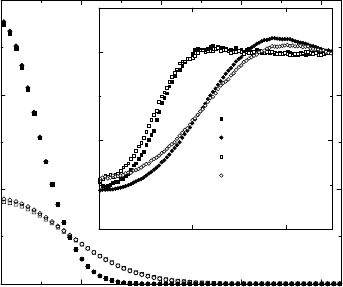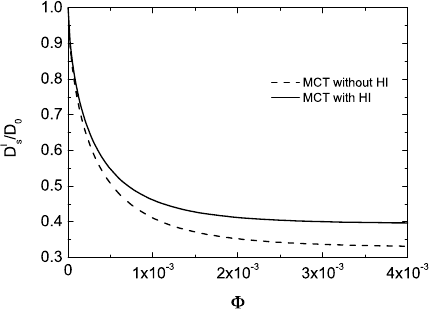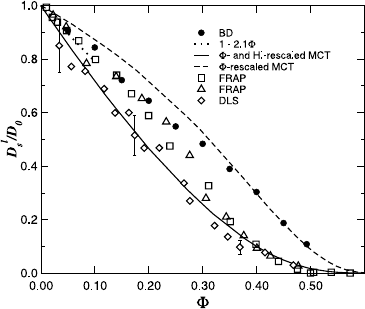Heitjans P., Karger J. (Eds.). Diffusion in Condensed Matter: Methods, Materials, Models
Подождите немного. Документ загружается.


690 Gerhard N¨agele, Jan K. G. Dhont, and Gerhard Meier
02468
r/σ
0
0.2
0.4
0.6
G
s
(r,t)/ρ
024
r/σ
0
0.5
1
G
d
(r,t)/ρ
full HI
p−w HI
p−p HI
no HI
Fig. 16.25. Reduced self-dynamic and distinct Van Hove functions, G
s
(r, t)/ρ
0
and
G
d
(r, t)ρ
0
versus r/(2a), for time t =3.5 τ
I
, particle surface fraction Φ =0.062, and
an effective particle charge Q of 10
3
elementary charges. After [74].
ρ
0
, G
d
(r, t) is thus the time-dependent generalization of the radial distrib-
ution function. Real-space quantities like G
s
(r, t), G
d
(r, t)andW (t)canbe
directly measured in quasi-two-dimensional systems of micron-sized colloidal
particles using video microscopy imaging [82,83]. The functions G
s
(r, t)and
G
d
(r, t) are the Fourier transform pairs, respectively, of S
s
(q, t)andofthe
distinct part, S
d
(q, t)=S
c
(q, t) − S
s
(q, t), of S
c
(q, t), viz.
S
s
(q, t)=
dr exp{iq · r}G
s
(r, t) (16.230)
S
d
(q, t)=
dr exp{iq · r}G
d
(r, t) .
The time t =3.5 τ
I
, at which the reduced Van Hove functions G
s
(r, t)/ρ
0
and
G
d
(r, t)/ρ
0
are depicted in Fig. 16.25 versus the radial distance r corresponds
to the intermediate time regime characterized by a sub-linear increase in
W (t). Interestingly enough, the shape of G
d
(r, t) with full HI (i.e p-p and p-w
HI) is seen from the figure to be mainly determined by p-p HI. In comparison,
the p-w HI has only a minor effect on G
d
(r, t), giving rise to a somewhat slower
decay of interparticle correlations. In sharp contrast to G
d
(r, t), G
s
(r, t)is
mainly influenced hydrodynamically by the walls (i.e. by p-w HI), which act
to slow down the self-diffusion. This is the reason why the G
s
(r, t)withfull
HI and with p-w HI alone, which are nearly equal to each other, are much
larger for smaller r than the G
s
(r, t) for the non-confined cases of of p-p HI
only and with no HI at all.
Aside from BD and SD computer simulations, various approximate theo-
retical methods have been developed [27, 48, 84–91] for calculating long-time

16 Diffusion in Colloidal and Polymeric Systems 691
diffusional and rheological properties from the knowledge of S
c
(q) or, like-
wise, g(r). These methods are all based, regarding S
c
(q, t), on the microscopic
equivalent of the phenomenological memory (16.101), with different approxi-
mations involved in each of these methods for the memory function ∆D
c
(q, t).
Out of these methods, we discuss here only the mode coupling theory (MCT)
for the overdamped dynamics of dense colloidal suspensions [27,68,86,89,91].
The MCT for Brownian systems has been established, through comparison
with experiment and computer simulations, as a versatile tool for calculating
dynamic transport coefficients and density correlation functions [24, 56, 92].
In order to derive a microscopic evolution equation for S
c
(q, t) it should be
realized that the microscopic densities ρ
A
(q,t), with A ∈{s, c},aretheonly
slowly relaxing dynamic variables, at least for small q (cf. (16.132)), since
momentum and energy of the colloidal spheres are very quickly exchanged
with the surrounding fluid. From introducing the projection operator into the
subspace of configurational dynamic variables,
ˆ
P
c
(···)=
(···)ρ
c
(−q)
NS
c
(q)
ρ
c
(q) , (16.231)
N¨agele and Baur have derived the following exact evolution equation for
S
c
(q, t) [68]:
∂
∂t
S
c
(q, t)=−q
2
D
s
c
(q)S
c
(q, t) −
t
0
duM
irr
c
(q, t − u)
∂
∂u
S
c
(q, u) . (16.232)
This equation relates S
c
(q, t) to the so-called irreducible collective memory
function M
irr
c
(q, t). The function M
irr
c
(q, t) is given by an exact but for-
mal equilibrium average invoking
ˆ
P
c
and the adjoint Smoluchowski operator
ˆ
O
B
(r
N
) (see [27, 68] for details).
Time-Laplace transformation of (16.232) leads to
S
c
(q, z)=
S
c
(q)
z +
q
2
D
s
c
(q)
1+M
irr
c
(q, z)
, (16.233)
with M
irr
c
(q, z) the Laplace transform of M
irr
c
(q, t). It follows from this equa-
tion that the collective diffusion kernel, D
c
(q, z), in (16.91) can be expressed
in terms of M
irr
c
(q, t)via
D
c
(q, z)=
D
s
c
(q)
1+M
irr
c
(q, z)
. (16.234)
At this point, it becomes obvious that M
irr
c
(q, z) renormalizes the short-time
decay rate, q
2
D
s
c
(q), of S
c
(q, t) due to the presence of memory effects. As a
generalization of the single-particle Stokes-Einstein relation D
0
= k
B
T/γ to
interacting particle systems, a wavenumber and frequency-dependent friction

692 Gerhard N¨agele, Jan K. G. Dhont, and Gerhard Meier
function, γ
c
(q, z), can be introduced through D
c
(q, z)=k
B
T/γ
c
(q, z). Hence,
with (16.234), M
irr
c
(q, z) is identified as being proportional to the frequency-
dependent part of the generalized friction function. For given M
irr
c
(q, z), the
long-time collective diffusion coefficient can be calculated from
D
l
c
=
D
s
c
1+M
irr
c
(q → 0,z → 0)
. (16.235)
On the basis of the microscopic expression for M
irr
c
(q, t), it can be shown for
vanishing or pairwise additive HI that M
irr
c
(q, t)/q
2
→ 0forq → 0, which
implies that D
l
c
= D
s
c
.
The MCT provides a self-consistent approximation for M
irr
c
(q, t), which
preserves the positive definiteness of the exact D
c
(q, z). It is particularly
suitable for fluid suspensions of strongly correlated particles. Moreover, as
shown in the salient work of G¨otze and co-workers (see [93–96]), it predicts a
consistent dynamic glass transition scenario in good accord with experiment
and computer simulation. This scenario is characterized by the appearance
of non-ergodicity above a certain concentration threshold, where S
c
(q, t)and
S
s
(q, t) do not relax any more to zero, and where the suspension viscosity
diverges.
In the most commonly used version of the MCT, M
irr
c
(q, t) is approxi-
mated without HI by
M
irr
c
(q, t)=
D
0
2ρ
0
(2π)
3
dk [V
c
(q, k)]
2
S
c
(k, t) S
c
(|q − k|,t) (16.236)
with the vertex amplitude [87, 91,93, 94],
V
c
(q, k)=
ˆ
q · k ρ
0
c(k)+
ˆ
q · (q − k) ρ
0
c(|q − k|) , (16.237)
related to collective diffusion. Here, c(q)=[1− 1/S
c
(q)]/ρ
0
is the Fourier
transform of the two-body direct correlation function c(r) [50]. The ver-
tex amplitude V
c
(q, k) in (16.236) has been derived in the so-called con-
volution approximation, where the contribution of static three-point direct
correlations is neglected. The convolution approximation for the collective
vertex amplitude is used in most of the recent applications of the MCT to
atomic [95–97] and colloidal dynamics [24,27, 88, 90, 91].
The MCT has been formulated further for self-diffusional properties re-
lated to the self-dynamic structure factor S
s
(q, t). The time evolution of
S
s
(q, t) is described by the exact memory equation [68],
∂
∂t
S
s
(q, t)=−q
2
D
s
s
S
s
(q, t) −
t
0
duM
irr
s
(q, t − u)
∂
∂u
S
s
(q, u) , (16.238)
which includes the irreducible memory function, M
irr
s
(q, t), related to self-
diffusion. Without HI, D
s
s
= D
0
,andM
irr
s
(q, t) is then approximated in
MCT by

16 Diffusion in Colloidal and Polymeric Systems 693
M
irr
s
(q, t)=
D
0
(2π)
3
ρ
0
dk [V
s
(q, k)]
2
S
c
(k, t) S
s
(|q − k|,t) , (16.239)
with the vertex function [87]
V
s
(q, k)=
ˆ
q · k (1 −
1
S
c
(k)
) . (16.240)
Equations (16.232, (16.236) and (16.237) constitute a self-consistent set of
non-linear equations determining S
c
(q, t) for a given static structure factor
S
c
(q). The latter can be calculated independently for given pair potential
using well-established integral equation schemes [18, 50].
Once S(q, t) has been determined, S
s
(q, t) is obtained from solving (16.238)–
(16.240). Knowing S
s
(q, t), the MSD can be determined from
W (t)=− lim
q→0
log S
s
(q, t)
q
2
. (16.241)
The long-time self-diffusion coefficient, D
l
s
, follows then from
D
l
s
= lim
t→∞
W (t)
t
=
D
s
s
1+M
irr
s
(q → 0,z → 0)
, (16.242)
where M
irr
s
(q, z) is the Laplace transform of M
irr
s
(q, t).
An approximate incorporation of far-field HI into the MCT equations of
monodisperse systems and colloidal mixtures was provided by N¨agele and co-
workers [27,68,86]. This leads to modifications in the wavenumber dependence
of V
c
(q, k)andV
s
(q, k), and hydrodynamic functions like H(q) are needed as
additional external inputs. The MCT with far-field HI aims at describing the
dynamics of charge-stabilized suspensions in the fluid regime. So far it has
been applied with good success to the self-diffusion of moderately correlated
charged particles (see below), and to the electrolyte friction effect experienced
by a charged colloidal sphere immersed in an electrolyte solution [98].
Figure 16.8 shows BD results without HI for the S
c
(q, t) of a charge-
stabilized dispersion, in comparison with corresponding MCT prediction
without HI. There is no adjustable parameter involved in this comparison.
The good agreement between MCT and BD for all times and wavenumbers
considered confirms our earlier statement that the MCT is well suited for
dense (in the sense of strongly correlated) particle systems. The effect of far-
field HI, which is predominant in charge-stabilized suspensions, is to enlarge
D
l
s
moderately, and to enhance the decay of S
c
(q, t). The enhancement of
D
l
s
had been originally predicted in [68] from partially self-consistent sim-
plified MCT calculations of D
l
s
with far-field HI included (see Fig. 16.26),
and from exact low-density calculations. Meanwhile, hydrodynamic enhance-
ment of long-time self-diffusion has been observed in various colloidal systems
characterized by strong and long-range particle repulsions [74,76–78,80]. The

694 Gerhard N¨agele, Jan K. G. Dhont, and Gerhard Meier
Fig. 16.26. MCT long-time self-diffusion coefficient of a typical deionized charge-
stabilized suspension as function of volume fraction. HI leads here to an enhance-
ment of long-time diffusion (see [68, 87]).
far-field HI prevailing in these systems promotes the diffusion of a sphere out
of its momentary cage.
A neutral sphere diffusing out of its cage of neighboring hard spheres will,
contrary to charged spheres, most probably pass by very closely to one of the
caging particles, since the g(r) of hard spheres is maximal at contact. Due to
the strongly reduced relative mobility of two spheres near contact, the long-
time self-diffusion of a hard sphere is hydrodynamically reduced accordingly.
Consider here Fig. 16.27, which shows BD results for the D
l
s
of hard spheres
without HI included, versus experimental data obtained from FRAP and DLS
measurements. For hard spheres, D
l
s
/D
0
=1− 2.1Φ to leading order in the
density. While there are significant differences in D
l
s
for the various sets of
experimental data, the hydrodynamically induced de-enhancement of D
l
s
for
hard spheres is clearly observable. The diverging experimental results for D
l
s
arise from difficulties in determining the volume fraction unambiguously. Fig.
16.27 includes further the MCT predictions for D
l
s
without and with HI. The
MCT locates the glass transition of hard-sphere suspensions at Φ =0.525
which is lower than the experimental value of approximately 0.58. To correct
for this, Φ is rescaled in the MCT results accoding to Φ → Φ × Φ
g
/0.525,
with a value Φ
g
=0.62 selected somewhat larger than the experimental one,
so that the MCT-D
l
s
without HI conforms well with the BD data at large
concentrations. The influence of many-body HI is accounted for in a semi-
heuristic fashion by multiplying (i.e. rescaling) D
l
s
without HI, calculated
using the MCT, by the factor D
s
s
/D
0
where D
s
s
is determined from (16.210).
A rationale for this hydrodynamic rescaling is provided from noting for hard
spheres that a particle diffusing out of its cage will move very slowly for
a considerable amount of time in the immediate neighborhood of a caging
sphere, as adequately described by the short-time self-diffusion coefficient,

16 Diffusion in Colloidal and Polymeric Systems 695
Fig. 16.27. Reduced long-time self-diffusion coefficient for hard spheres as function
of volume fraction. Comparison between MCT and experimental data. Filled circles:
BD data of Moriguchi et al. [100]. Open diamonds: DLS data of van Megen and
Underwood [101]. Open squares and triangles: two sets of FRAP data by Imhof
and Dhont [102]. After [24].
before it leaves the cage. According to Fig. 16.27, the D
l
s
from the HI-rescaled
MCT is overall in good accord with experimental data, in particular for larger
concentrations.
An empirical dynamic freezing rule, due to L¨owen, Simon and Palberg
[99], states that freezing sets in in a three-dimensional monodisperse suspen-
sion when the threshold value D
l
s
/D
s
s
≈ 0.1 has been reached. A value of
0.1forD
l
s
/D
0
corresponds to Φ =0.949 within the HI-rescaled MCT. Since
S
c
(q
m
; Φ =0.494) = 2.85, this is also the freezing volume fraction predicted
by the static Hansen-Verlet freezing criterion [59]. This observation suggests
that both freezing criteria are in fact equivalent, since dynamic properties are
derived in MCT from knowledge of the static property S
c
(q). The equivalence
of both freezing criteria, and of their two-dimensional analogues, has been
further established for systems with long-range repulsive interactions [24,76].
The equivalence of static and dynamic criteria derives from a general dy-
namic scaling behavior (cf. [58,76] for details on this dynamic scaling), which
has led to the formulation of additional dynamic freezing criteria in terms of
long-time collective diffusion coefficients [58].
As an example of dynamic scaling, consider Fig. 16.28a. This figure in-
cludes the master curve for D
l
s
versus S(q
m
), calculated using the MCT
without HI for a three-dimenisional suspension of highly charged spheres.
Note here that a height of 2.85 in the static structure factor peak corre-
sponds to D
l
s
/D
0
=0.1. Recall further that D
s
s
≈ D
0
for charge-stabilized
systems with prevailing far-field HI. BD simulation results of D
l
s
/D
0
versus
S
c
(q
m
) with and without far-field HI included are shown in Fig. 16.28b for
magnetically and electrostatically repelling particles. We observe here that

696 Gerhard N¨agele, Jan K. G. Dhont, and Gerhard Meier
1.0 2.0 3.0 4.0 5.0
S(q
m
)
0.00
0.20
0.40
0.60
0.80
D
S
L
/D
0
CS
2.85
M−ST
M−WX
G+L
M−YZ
H
0.1
(a)
123456
S(q
m
)
0
0.2
0.4
0.6
0.8
1
D
S
L
/D
0
magnetic (HI)
Yukawa (HI)
magnetic (without HI)
Yukawa (without HI)
5.5
0.085
(b)
Fig. 16.28. Reduced long-time self-diffusion coefficient, D
l
s
/D
0
, versus liquid static
structure factor peak height S
c
(q
m
). MCT results without HI (from [24]) for deion-
ized three-dimensional suspensions of charge-stabilized spheres are shown in (a).
The particle interactions in (a) are described by a Yukawa-like screened Coulomb
potential. BD simulation results with and without HI for magnetic and charge-
stabilized (Yukawa-like) quasi-two-dimensional systems are depicted in (b) (af-
ter [58]).
D
l
s
/D
0
≈ 0.085 for S
c
(q
m
) ≈ 5.5, in excellent accord with an empirical dy-
namic criterion for two-dimensional freezing proposed by L¨owen [103], which
states that D
l
s
/D
0
≈ 0.085 at the freezing line, independent of the pair poten-
tial and the nature of the freezing process. Moreover, a value of S
c
(q
m
)=5.5
at freezing is indeed found in computer simulations of two-dimensional sys-
tems [104]. As seen from Fig. 16.28b, values of D
l
s
close to freezing are only
slightly enhanced by HI. This indicates that the dynamic freezing rules re-
main esentially untouched when far-field HI is included.
As an application of the MCT to colloidal mixtures, we consider long-time
interdiffusion in a dilute binary mixture of colloidal hard spheres. To this end,
one needs to employ the generalizations of the one-component MCT equations
to colloidal mixtures, as provided, e.g., in [27]. The long-time mobility matrix
µ
l
, defined in (16.121), can be calculated analytically without HI to yield [27]
k
B
Tµ
l
αβ
= δ
αβ
D
l
sα
+
1
3
D
0
α
(Φ
α
Φ
β
)
1/2
(1 + λ
αβ
)
2
(λ
αβ
)
3/2
+ O(Φ
2
) (16.243)
where
D
l
sα
= D
0α
1 −
1
3
Φ
2
γ=1
x
γ
(1 + λ
γα
)
2
+ O(Φ
2
) (16.244)
is the long-time self-diffusion coefficient, without HI, of an α-type hard sphere
in the mixture. Here, Φ is the total volume fraction of both components,
and λ
αβ
= a
β
/a
α
is the size ratio of β to α spheres. The MCT result in

16 Diffusion in Colloidal and Polymeric Systems 697
(16.243) and (16.244) is not an exact one: the exact expression for D
l
sα
is given
by (16.244) with the factor 1/3 replaced by 1/2 [18, 42], so that D
l
s
/D
0
=
1 − 2Φ + O(Φ
2
) in the mondisperse case. The MCT does not describe the
dynamics at low densities exactly, since the low-density binary collision part
is treated in an approximative way.
Substitution of (16.243) for µ
l
in (16.130) yields the following MCT result
for the kinetic factor of a dilute binary hard sphere suspension [27,105]:
Λ
l
in
x
1
x
2
=
x
2
D
l
s1
+ x
1
D
l
s2
+
4
3
(x
1
Φ
2
D
02
+ x
2
Φ
1
D
01
)
−
2
3
(x
1
x
2
Φ
1
Φ
2
)
1/2
D
01
(1 + λ
12
)
2
(λ
12
)
3/2
. (16.245)
As has been discussed already in the interdiffusion part of Sect. 16.3.2, an
ideal binary mixture is characterized by Λ
l
in
∝
x
2
D
l
s1
+ x
1
D
l
s2
; i.e., Λ
l
in
can then be expressed completely in terms of the self-diffusion coefficients.
Equation (16.245) implies that a binary mixture of hard spheres is non-ideal
already at small concentrations. Ideality is reached only when a
1
= a
2
, i.e.
for labelled but otherwise identical particles.
16.5.2 Polymer Blends and Random Phase Approximation
In this subsection, we analyze the interdiffusion process in binary polymer
blends of hompolymers, labelled as A and B. We further consider the inter-
diffusion of A and B polymers in a matrix of C polymers. Our analysis is
restricted to length scales accessible to dynamic light scattering. The lengths
2π/q resolved in typical DLS experiments on polymer blends are much larger
than the average extent of a polymer coil. The average coil size is quantified
by the radius of gyration, R
G
,withR
G
= pa
2
/6 for a Gaussian chain. Here,
p is the degree of polymerization, i.e. the number of statistical segments or
monomers [13, 47, 106], of a homopolymer chain, and a is the length of a
statistical segment. DLS experiments performed in the macroscopic regime,
i.e. in the diffusive limit where qR
G
1 holds, resolve times which are large
as compared to the internal modes of a chain in the melt. Hence, only the
center-of-mass diffusion of a chain is resolved.
As discussed earlier in Sect. 16.3.2, the partial static structure factors in
a mixture are expressible, in the hydrodynamic limit, as a linear superposi-
tion of exponentially decaying hydrodynamic modes (cf. (16.122)). To make
contact with the notation commonly used in the polymer field with regard to
interdiffusion [28,29], we slightly redefine the partial collective dynamic struc-
ture factor, S
αβ
(q, t), for the density correlations of α and β-type monomers
as S
αβ
(q, t)=ρ
α
(q,t)ρ
β
(−q, 0), which differs from the definition given in
(16.118) by a factor of (N
α
N
β
)
1/2
. In the context of polymer blends, N
α
de-
notes the total number of α-type monomers in the melt, with α ∈{A, B, C},

698 Gerhard N¨agele, Jan K. G. Dhont, and Gerhard Meier
and ρ
α
(q,t) is the incremental number density given in (16.115), with r
α
j
pointing to the location of the j-th monomer of type α.
Using this redefinition of the S
αβ
(q, t), the EACF for a binary blend is
(cf. (16.119))
g
E
(q, t) ∝ b
2
A
S
AA
(q, t)+b
2
B
S
BB
(q, t)+2b
A
b
B
S
AB
(q, t) , (16.246)
where b
α
is the scattering amplitude of an α-type monomer (q-independent in
the diffusive limit), related to its dielectric polarizability. Equation (16.246)
applies also to an incompressible ternary blend, with b
A
and b
B
interpreted
now as the excess scattering amplitudes relative to the amplitude, b
C
,of
matrix monomers. The incremental number density, ρ
C
, of matrix molecules is
hereby contracted out of the description, by using the local incompressibility
constraint (cf. (16.124)),
ρ
A
(q,t)+ρ
B
(q,t)+ρ
C
(q,t)=0, (16.247)
for the coarse-grained incremental number densities,
ρ
α
(q,t). In (16.247), it
is assumed that the thermodynamic segmental volumes of the three polymer
species are equal.
The interdiffusion of A chains into B chains in the ternary mixture is
described by the interdiffusion autocorrelation function,
S
in
(q, t)=
1
N
2
A
S
AA
(q, t)+
1
N
2
B
S
BB
(q, t) −
2
N
A
N
B
S
AB
(q, t) , (16.248)
which differs from the definition of S
in
(q, t) in (16.117) by a factor (Nx
A
x
B
)
−1
,
with N = N
A
+ N
B
. Here, x
A
= N
A
/N is the molar fraction, i.e. the volume
fraction for equal molar volumes, of A monomers relative to A and B, with
x
B
=1− x
A
. The long-time interdiffusion coefficient has been defined in
(16.126) in terms of the initial decay rate of S
in
(q, t)as
D
l
in
= −
1
q
2
∂
∂t
ln S
in
(q, t)|
t=0
, (16.249)
where it is understood that the diffusive limit of S
in
(q, t)istakenbeforeits
evaluation at t =0.The2×2-matrix, µ
l
, of long-time partial mobilities µ
αβ
for the components A and B is introduced, in accordance with (16.121), by
k
B
Tµ
l
αβ
= −
1
q
2
∂
∂t
S
αβ
(q, t)|
t=0
. (16.250)
Then, D
l
in
in (16.249) can be re-expressed as [28]
D
l
in
=
Λ
l
in
S
in
= k
B
T
µ
l
AA
N
2
A
+
µ
l
BB
N
2
B
−
2µ
l
AB
N
A
N
B
S
AA
N
2
A
+
S
BB
N
2
B
−
2S
AB
N
A
N
B
. (16.251)

16 Diffusion in Colloidal and Polymeric Systems 699
This equation relates D
l
in
to the long-time and long-wavelength-limiting par-
tial mobilities and partial static structure factors of A and B monomers. The
definition of the µ
αβ
in (16.250) differs from the one in (16.121) by the same
factor (N
A
N
B
)
1/2
as for the partial static structure factors, so that D
l
in
in
(16.251) is not affected by these redefinitions.
In the interdiffusion part of Sect. 16.3.2 we have pointed out that, in
general, D
l
in
cannot be determined by a single scattering experiment. An
important exemption from this rule is an incompressible binary blend of A
and B polymer chains, void of any vacancies or C polymers. In this case, local
incompressibility,
ρ
A
+ ρ
B
= 0, implies that
S
AA
(q, t)=S
BB
(q, t)=−S
AB
(q, t) , (16.252)
from which follows with (16.246) and (16.248) that
g
E
(q, t) ∝ S
in
(q, t)=
1
N
A
+
1
N
B
2
S
αα
(q)exp{−q
2
D
l
in
t}, (16.253)
with α = A or B. It can be shown that the amplitude A
+
in the normal mode
expansion of (16.122) vanishes in case of an incompressible binary blend, so
that the (+)-mode with eigenvalue d
+
is not observable. The relaxation coef-
ficient d
+
is identified here with the so-called cooperative diffusion coefficient,
which quantifies the long-time relaxation of fluctuations in the total number
density ρ
A
+ ρ
B
[28]. In identifying the normal mode d
−
with D
l
in
,wecan
state that in an incompressible binary blend, a measurement of g
E
(q, t) yields
the interdiffusion coefficient, given here as
D
l
in
= k
B
T
µ
l
αα
S
αα
, (16.254)
since µ
l
αα
= µ
l
ββ
= −µ
l
αβ
according to (16.250) and (16.252).
To make further progress in determining the interdiffusion coefficient of
binary and ternary melts, a method is needed for calculating the µ
l
αβ
and S
αβ
in (16.251). For an approximate calculation of the µ
l
αβ
, we employ a dynamic
extension of the random phase approximation (RPA) of polymer blends. The
dynamic RPA is a self-consistent mean-field-type approach based on lin-
ear response theory, which relates the (Laplace-transformed) linear response
function , −β(d/dt)S
αβ
(q, t), of the actual system of interacting chains, to
the response function, −β(d/dt)S
0
αβ
(q, t), of a bare reference system of non-
interacting chains. For a derivation of the dynamic RPA, we refer to the work
of de Gennes [107], Brochard and de Gennes [108], and for the extension of
the RPA to incompressible polymer mixtures with an arbitrary number of
components to Akcasu and Tombakoglu [109].
In the dynamic RPA, the static and dynamic properties of the bare system
are assumed to be known. The bare system is commonly chosen as one which
is identical to the original mixture in all respects except for the absence
